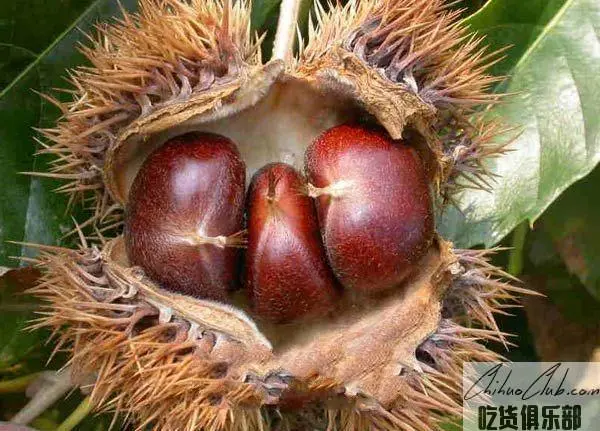
Queshan chestnut
-
Update date::
-
Date of protection::
-
Protected range:The scope of protection of the authentic mountain chestnut geographical indication products is based on the scope of the “Recommendation on Defining the Scope of Protection of the Geographical Signs of the Chestnuts of the Mountain” (Chengzheng [2004] No. 90) of the People's Government of Henan Province. Shan County has jurisdiction over administrative areas.
-
Related origin:henan zhumadianshi queshanxian zhumadianshi-yangbuzhen-henan queshanxian-langlingjiedao queshanxian-liudianzhen queshanxian-liuzhuangzhen queshanxian-lixindianzhen queshanxian-panlongjiedao queshanxian-puhuisizhen queshanxian-rendianzhen queshanxian-sanlihejiedao queshanxian-shigunhezhen queshanxian-shuanghezhen queshanxian-wagangzhen queshanxian-xinandianzhen queshanxian-zhugouzhen pingyuxian-yangbuzhen pingyuxian
-
Category:
Indeed, the mountain is in the transitional zone between the north subtropical zone and the southern warm temperate zone. The climate is humid, the rain and heat are in the same period. The light, heat and water conditions are very suitable for the growth of chestnut, and most of these places are gravel soil, sandy loam soil, yellow brown loam, and the soil layer is deep. The organic matter content is high. It is this unique climatic condition that forms the unique quality of the chestnut with bright color, large nuts, thick flesh, fine meat, rich nutrition and sweet taste.
Quality characteristics in the senses, compared with the southern chestnut, the mountain chestnut has the characteristics of the southern fruit shape, and overcomes the shortcomings of poor color and poor quality of the chestnut in the south; compared with the chestnut in the north, the color, quality and resistance The storage is equivalent, but it overcomes the characteristics of the small chestnut nuts in the north. Geographical advantage The mountain chestnut is produced in the mountainous area of the south of Henan Province. Indeed, the mountain is located in the transition zone from subtropical to warm temperate zone. The four seasons are distinct, the rainfall is abundant, the sunshine is sufficient, the soil is fertile, and it is suitable for the growth of a variety of forest fruits. Among them, the mountain chestnuts are rich in nuts, beautiful in color, bright in oil and bright in the earth. It is famous for its easy peeling, easy storage, delicate meat, rich nutrition, sweet and delicious taste. Chestnut has a long history of cultivation. Chestnut is rich in protein, sugar, starch and other nutrients needed by the human body. It is a nutritious food. Chestnut fruit also contains vitamin C, E, lipase, iron, calcium, phosphorus and other ingredients. More chestnut fruit can nourish the stomach and strengthen the spleen, promote blood circulation and stop bleeding. It has the effect of beauty and longevity. The varieties of chestnuts in the mountains are the most common in red oil, accounting for 60% of the planted area; the second is purple oil, accounting for 30%.
Exact mountain chestnut quality technical requirements (a) variety. It is indeed red chestnut, indeed mountain oil chestnut. (2) Cultivation management. 1. Seedlings: Seedlings are cultivated by grafting. 2. Planting: Select yellow and yellow sandy soils of granite and shale, and slopes, hills and rivers (roads) with slopes below 25°. The soil has a pH of 5.5G to 6.8. Each 667 (mu) is set at 42 to 56 plants. 3. Fertilization: For every 1% of the base fertilizer, apply about 5? of organic fertilizer, mix with appropriate amount of phosphorus and potassium fertilizer, and apply it at the end of autumn and winter. 4. Water and fertilizer management: After the germination, the quick-acting nitrogen fertilizer is applied; before the fruit is swollen (40 days before harvesting), the available nitrogen, phosphorus and potassium fertilizers are applied; the water conservation measures are carried out by using water conservation measures such as undergrowth and mulching. In the flowering period, when the fruit is inflated, it should be timely flooded. 5. Trim: Use natural happy shape or evacuated layered shape. After planting, the year is fixed, the dry height is about 80cm; when the young shoots grow to about 30cm, the topping is carried out; the result is that the tree pruning maintains a strong tree, balances the branches, and removes the dense branches, cross branches and thin branches; When the peripheral branches appear to have a coke tip dry top, they retract and renew, and select the strong branches from the new branches that promote the hair to cultivate the mother branches. (3) Harvesting and fruit processing. After the natural cracking, the pickles are picked up in time, or the total sorghum is piled up and cooked, and artificial threshing is carried out. (4) Quality characteristics. 1. Appearance characteristics: oily gloss is strong, the meat is fine and sturdy, the flavor is unique and the aroma is thick, the nuts are full, the suede is easy to peel and is resistant to storage. 2. Physical and chemical indicators: The water content of red chestnut fresh fruit is 41.7%, total sugar is 9.38%, protein is 4.15%, fat is 1.2%, starch is 36.13%; true mountain water content is 39.88%; total sugar is 9.83%; starch is 38.3%; Protein 4.08%; fat 1.2%.
Apply to:
Producers within the scope of protection of the ceremonial products of the sacred chestnuts may submit an application to the Bureau of Quality and Technical Supervision of the Queshan County for the use of the “Special Mark for Geographical Indication Products”, which shall be approved by the General Administration of Quality Supervision, Inspection and Quarantine.